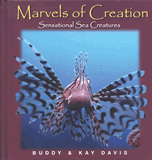Fast Fish Evolutionary Response
PhysOrg: “Tiny Fish Evolved to Tolerate Colder Temperature in Three Years: Study” “[O]ne of the fastest evolutionary responses ever recorded in wild populations,” claims a press release about recent research. But is it really “evolution”?
The claim concerns stickleback fish, that have been used as evidence of evolution before (in May and September 2008 and February 2009). This time, scientists began by bringing both freshwater and marine sticklebacks into the lab and testing how well each type could withstand cold water temperatures.
Sticklebacks living in freshwater can endure water temperatures of 2.5˚C (4.5˚F) colder than sticklebacks that live in a marine environment.
The results did not surprise the scientists: sticklebacks living in freshwater can endure water temperatures of 2.5˚C (4.5˚F) colder than sticklebacks that live in a marine environment. “This made sense from an evolutionary perspective because their ancestors were able to adapt to freshwater lakes, which typically reach colder temperatures than the ocean,” explained University of British Columbia zoologist Rowan Barrett. Of course, because Barrett is referring to the process of adaptation by natural selection, this makes sense from a creationist perspective as well. But that’s not the fast evolutionary response at the center of the research; in fact, evolutionists believe freshwater and marine sticklebacks diverged 10,000 years ago.
In a twist, Barrett’s team decided to introduce some marine sticklebacks to freshwater ponds to determine how long it would take the newly introduced population to develop increased cold tolerance. To their surprise, the new freshwater stickleback population was as tolerant of cold water as other freshwater sticklebacks after only three years. But “[o]nly rare individuals that possess[ed] the ability to tolerate rapid changes in temperature survive[d],” cautioned Barrett.
Creationists shouldn’t be surprised at how quickly natural selection worked, allowing the marine stickleback population to adapt to freshwater. This three-year example of stickleback “evolution” is a soft echo of the adaptation and speciation that would have occurred in the centuries after the Ark landed—and in the millennia since. Therefore the speed of change in this case shows that it’s quite reasonable to view today’s diversity of land animals (the creatures on the Ark, that is) as having come about since the Flood.
Furthermore, in stories like this we learn again how tricky the word “evolution” can be. Used in a general sense, it refers to any change in a population, which is certainly not the kind of change that—even with billions of years—could transform a fish into a scientist who studies fish. Also, note that some marine sticklebacks didn’t survive the colder water, which means that it’s possible that the population lost some genetic information (and certainly gained none). This is the opposite of the prediction of Darwinian, molecules-to-man evolution.
For more information:
Remember, if you see a news story that might merit some attention, let us know about it! (Note: if the story originates from the Associated Press, Fox News, MSNBC, the New York Times, or another major national media outlet, we will most likely have already heard about it.) And thanks to all of our readers who have submitted great news tips to us.
(Please note that links will take you directly to the source. Answers in Genesis is not responsible for content on the websites to which we refer. For more information, please see our Privacy Policy.)
Recommended Resources

Answers in Genesis is an apologetics ministry, dedicated to helping Christians defend their faith and proclaim the good news of Jesus Christ.
- Customer Service 800.778.3390
- Available Monday–Friday | 9 AM–5 PM ET
- © 2025 Answers in Genesis






